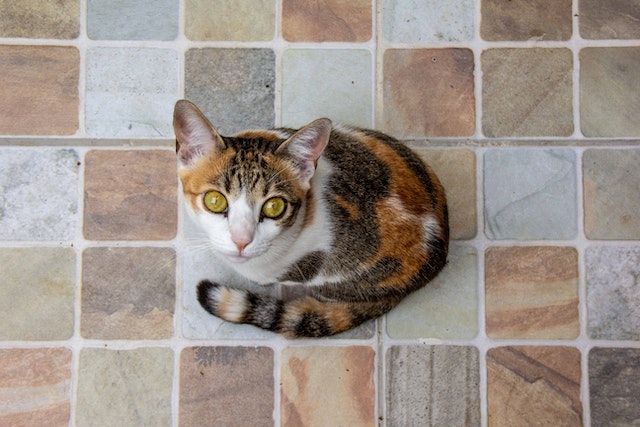Calico Cat Health Problems and Lifespan
Posted: 07/17/2024 | BY: Jenna Bruce | Categories: Cat , Health problems , Pet care
If you are a cat lover, you probably still remember the first time you saw a Calico in person. These cats are so beautiful, thanks to their uniquely distinctive coats, that they seem to be able to put a spell on some of us. If you have a Calico cat or are thinking of bringing one into your life, it’s important to understand how to take the very best care of them. And that starts with learning about Calico cat health problems to be aware of.

What Makes Calicos So Special?
First we should mention that Calicos are not a breed of cat unto themselves. Their name comes from the very unique pattern of their coat. And that pattern is a result of a pretty unique set of genetic traits.
Calico genetics is a fascinating topic and there has been much excitement and discussion about them in the research community. We could write an entire blog post about the Calico genetic traits, but we’ll keep things simple for now.
You’ve probably heard that the vast majority of Calico cats are female. Did you ever wonder why that is? The answer can be found in the Calico cat ‘s DNA and a phenomenon found in all female mammals called “X-chromosome inactivation.”
You may remember from biology class that females have two x-chromosomes while males have one x- and one y-chromosome. The y-chromosome contains very few genes but the x-chromosome contains over one-thousand genes that are necessary for proper development. However, because females contain two copies of the x-chromosome, they are at risk of a potentially toxic double dose of x-linked genes. Nature’s way of correcting this genetic disparity is through a mechanism called “X-chromosome inactivation.” And it is this mechanism that brings about the unique coat patterns in Calico cats!
In Calicos, the fur pigmentation gene is x-linked. One x-chromosome encodes an orange coat while the other gives black or tabby. Each cell in the cat’s body chooses which x-chromosome to leave active, which is why the black and orange mosaic pattern occurs.
In very rare cases, a male cat may have a chromosome makeup that contains an XXY-complement. This also allows the inactivation of one X-chromosome to take place which gives the male cats the familiar Calico pattern.

Calico Cat Health Problems and Lifespan
Because Calico cats are not a unique breed of cat, they tend to have a rather typical lifespan of about 12 to 16 years. The rare male Calico cat does have some unique health issues and may have a shorter life span as a result.
Because of that extra X-chromosome the male Calicos carry, they have a genetic condition called Klinefelter’s Syndrome. Cats with this syndrome can experience many health problems including cognitive issues, behavioral problems, brittle bones (that can lead to broken bones), and a higher body-fat content that can contribute to issues like diabetes and joint pain.

How to Care for Calico Cats
Caring for a healthy female Calico is no different than caring for any other cat. Be sure she eats a healthy balanced diet, gets plenty of exercise and sees the vet once a year for a checkup.
If you have a male Calico in your care, you’ll need to really stay on top of his health so you can spot any potential issues that may arise. You will probably need to bring him into the vet more than once a year, just so he can be checked out.
Pet Insurance Can Help You Care for Calico Health Problems
Whether you have a male or female Calico in your life, they will at some point most likely face a health issue that could be costly. If you’re like most pet parents, you don’t have thousands of dollars set aside for the expense of a sudan accident or unexpected illness.
A pet insurance plan can help you easily afford the very best care for your fur baby. Many plans cost less than $30 a month and some will even reimburse you for up to 90% of the vet bill.
Take two minutes to get a free customized quote right now. Once you enroll, experience peace of mind knowing you’re covered.
References:
- Ahn, J., & Lee, J. (2008). X chromosome: X inactivation. Nature Education, 1(1), 24.
- Centerwall, W. R., & Benirschke, K. (1975). An animal model for the XXY Klinefelter’s syndrome in man: tortoiseshell and calico male cats. American journal of veterinary research, 36(9), 1275-1280.
- Gartler, S. M., & Goldman, M. A. (2005). X‐chromosome Inactivation. eLS.
- Lyon, M. F. (1999). X-chromosome inactivation. Current Biology, 9(7), R235-R237.
Disclaimer
The information contained on this blog is intended for informational and educational purposes only and should not be construed as medical advice. It is not a substitute for professional veterinary care. Always consult with your veterinarian before making any changes to your pet's health care or treatment plan.
The authors of this blog are not veterinarians and do not claim to be experts in pet health. The information provided here is based on our own experiences and research, as well as information from reputable sources. However, we cannot guarantee the accuracy or completeness of this information.
We encourage you to do your own research and consult with your veterinarian before making any decisions about your pet's health.
Previous post
ACL Tears in Dogs: Signs, Causes and TreatmentNext post
Common Orange Tabby Cat Health IssuesCompare top pet insurance providers plans.
Enter your dog’s age in years and months to calculate their age equivalent to human years.
Calculate your dog’s ageEnter your cat’s age in years and months to calculate their age equivalent to human years.
Calculate your cat’s age